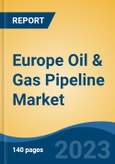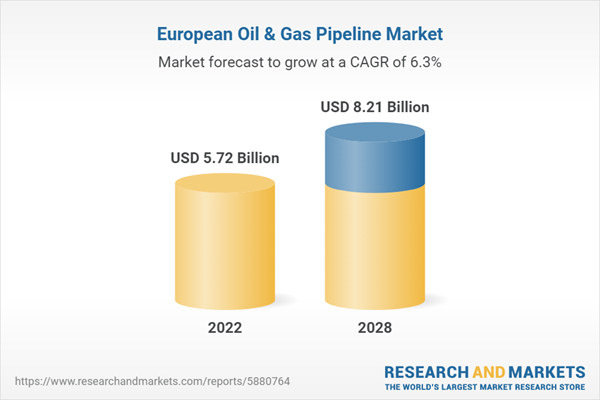Speak directly to the analyst to clarify any post sales queries you may have.
10% Free customizationThis report comes with 10% free customization, enabling you to add data that meets your specific business needs.
Pipelines are underground conduits used to distribute and transport fluids. Oil, oil byproducts, or natural gas are typical fluids that are transported through pipelines in an energy context. It will be necessary to use pipelines to carry hydrogen fuel if it is widely developed. Pipelines transport other fluids, such as water, outside energy-related contexts.
Increasing demand for crude oil and natural gas in developing countries Fuel the market Growth
According to the IEA' report, as Russia's war in Ukraine drives prices and feeds concerns about potential supply interruptions, the world's natural gas consumption is predicted to slightly decrease in 2022 and climb gradually over the next three years. Due to high gas prices, some consumers are switching to coal and oil instead of gas, and recent abrupt reductions in Russian gas flows to Europe have raised concerns about supply ahead of the winter. The decision by the European Union to gradually stop importing gas from Russia, historically its major supply, has an impact on other parts of the world because of the region's rising demand for LNG. The base case for the Gas Market Report forecasts a decline of over 55% in Russian pipeline gas exports to the EU between 2021 and 2025, but the report considers an expedited scenario in which the decline is over 75%.Growing technological advancements in the oil & gas
The 'Shale Revolution' in European production growth, which has led to an increase in output, has been made possible by new technologies in the oil and natural gas industries. Producers can reach oil and gas deposits from low-permeability geological formations that were previously too expensive to extract by combining hydraulic fracturing with horizontal drilling. Up until recently, the United States accounted for 25% of the world's oil demand, making it the greatest consumer. EOR is re-orienting the focus inward in several nations. For example, in Angola, building new resources can entail venturing into uncharted deep-water regions, a job that has driven some businesses back to established oilfields. EOR and carbon-capture technologies have been tested in Norway and the UK to maintain historically high production levels while lowering greenhouse gas emissions. Thermostatic, chemical, and gas injection methods are the three main types of tertiary production procedures. The most popular technique of the three makes use of gas and entails injecting large volumes of highly pressurized CO2 into existing oil reservoirs to lose the rock and displace any leftover hydrocarbons from tightly bound geological pores. Most oil and gas businesses currently using this technique are doing so on land. They use cutting-edge technology to increase pressure in deposits' hidden crevices and uncover these hitherto inaccessible resources.Increasing use of gas pipelines in residential as well as commercial applications industry
By linking gas sources to gas-consuming markets, gas pipeline infrastructure provides an efficient and secure way to transfer natural gas. The structure and growth of the gas market are governed by the grid of gas pipelines. To ensure enough supply and fair distribution of natural gas throughout the nation, an interconnected National Gas Grid has been envisioned. It has been planned to build a further 15,500 km of pipelines to complete the National Gas Grid, and these are currently in various stages of development to provide natural gas to the entire nation. It would guarantee easy access to natural gas in any region and may aid in achieving consistent economic and social advancement.Market Segmentation
The Europe Oil & Gas Pipeline Market is divided into type, application, and source. Based on type, the market is divided into crude oil pipeline and natural gas pipeline. Based on application, the market is divided into onshore and offshore. Based on source, the market is divided into upstream, midstream, and downstream. Based on country, the market is divided into Germany, United Kingdom, France, Italy, Spain, and Rest of Europe.Market Players
Major market players in the Europe Oil & Gas Pipeline Market are Saipem S.p.A., Subsea 7, McDermott International, Ltd, John Wood Group PLC, TechnipFMC plc, Sapura Energy Berhad, British Petroleum p.l.c., Royal Dutch Shell plc, Tenaris S.A.Report Scope:
In this report, the Europe Oil & Gas Pipeline Market has been segmented into following categories, in addition to the industry trends which have also been detailed below:Europe Oil & Gas Pipeline Market, by Type:
- Crude Oil Pipeline
- Natural Gas Pipeline
Europe Oil & Gas Pipeline Market, by Application:
- Offshore
- Onshore
Europe Oil & Gas Pipeline Market, by Source:
- Upstream
- Midstream
- Downstream
Europe Oil & Gas Pipeline Market, by region:
- Germany
- United Kingdom
- France
- Italy
- Spain
- Rest of Europe
Competitive Landscape
Company Profiles: Detailed analysis of the major companies present in the Europe Oil & Gas Pipeline Market.Available Customizations:
Europe Oil & Gas Pipeline Market report with the given market data, the publisher offers customizations according to a company's specific needs.This product will be delivered within 1-3 business days.
Table of Contents
Companies Mentioned
- Saipem S.p.A.
- Subsea 7
- McDermott International, Ltd
- John Wood Group PLC
- TechnipFMC plc
- Sapura Energy Berhad
- British Petroleum p.l.c.
- Royal Dutch Shell plc
- Tenaris S.A.
Table Information
| Report Attribute | Details |
|---|---|
| No. of Pages | 140 |
| Published | September 2023 |
| Forecast Period | 2022 - 2028 |
| Estimated Market Value ( USD | $ 5.72 Billion |
| Forecasted Market Value ( USD | $ 8.21 Billion |
| Compound Annual Growth Rate | 6.3% |
| Regions Covered | Europe |
| No. of Companies Mentioned | 9 |









